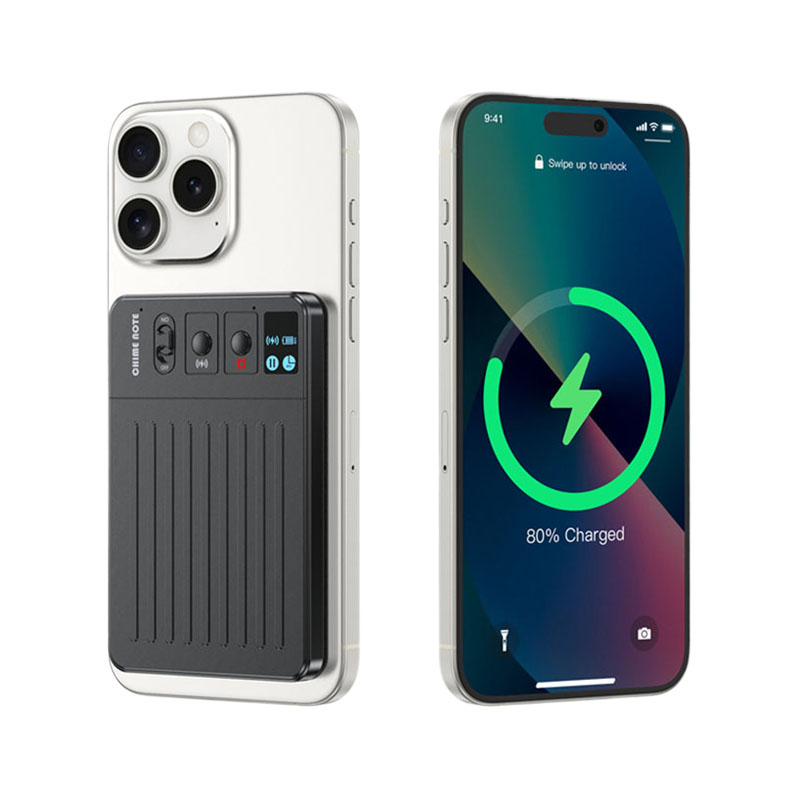How does AI recorder improve the accuracy of directional recording in noisy outdoor environments?
Release Time : 2025-10-22
In noisy outdoor environments, AI recorders require a multi-faceted collaboration of technologies, including hardware design, algorithm optimization, and scenario adaptation, to significantly improve directional recording accuracy. Its core principle lies in the dual effects of physical structural constraints and intelligent signal processing to suppress ambient noise and enhance the target sound source, thereby ensuring recording clarity.
The layout and selection of the microphone array are fundamental to directional recording. AI recorders commonly use a multi-microphone combination, such as a hybrid array structure of "2 directional + 6 omnidirectional." The directional microphones capture sound from the direction of the main sound source, their high sensitivity enabling precise reception of sound waves from specific angles. The omnidirectional microphones collect ambient sound from a 360-degree angle, providing comprehensive sound field information for subsequent algorithms. This layout enables the device to both focus on the target sound source and assist in noise analysis using omnidirectional data. For example, at an exhibition, the directional microphones prioritize the speaker's voice, while the omnidirectional microphones simultaneously record crowd noise, providing comparison samples for the noise reduction algorithm.
AI noise reduction algorithms are the core means of suppressing ambient noise. Deep learning-based noise reduction technology, trained on massive amounts of noise samples, can identify and filter out typical interference sources such as keyboard sounds and footsteps. For example, the VF2.0+ algorithm in a certain brand's AI recorder can optimize for over 80 types of office noise. By dynamically adjusting noise reduction parameters, it maintains the naturalness of human voices while eliminating background noise. In outdoor scenarios, the algorithm can further distinguish non-stationary noises such as wind and traffic, avoiding distortion caused by excessive noise reduction.
Beamforming technology achieves directional sound source enhancement through spatial filtering. This technology utilizes the phase differences of the microphone array to form a beam with signal gain in the target direction while attenuating noise from other directions. For example, in conference mode, the directional microphone on the top of the AI recorder is deactivated, and the omnidirectional microphone array on the body uses a weighted algorithm to form a focused beam in the direction of the speaker. This allows for clear capture of speech from up to five meters away, even in crowded outdoor venues. This technology is particularly suitable for scenarios such as interviews and lectures where a single sound source must be emphasized.
Multimodal scene recognition provides the basis for adaptive parameter adjustment. AI Recorder's built-in sensors detect ambient sound pressure levels, spectral distribution, and other characteristics in real time, automatically adapting to pre-set scene modes. For example, if high-frequency noise is detected, the device increases the weight of mid- and high-frequency noise reduction. If multiple people are speaking, it switches to multi-source separation mode. Some high-end models also support manual mode switching, allowing users to customize parameters such as microphone sensitivity and noise reduction intensity based on scenarios like "interview," "meeting," and "music."
Edge computing and cloud computing collaborate to enhance real-time processing capabilities. The local chip handles basic noise reduction and sound source localization, ensuring low-latency response, while a large cloud-based model handles complex semantic recognition and voiceprint separation. For example, during outdoor live broadcasts, the recorder can stream audio to the cloud in real time. The Spark Voice Simultaneous Interpretation model enables simultaneous transcription in 11 languages and 12 dialects, while also utilizing AI to generate structured meeting minutes. This architecture ensures stability for offline use while expanding its application across multiple languages and scenarios.
Sound source separation technology uses deep learning to decouple multiple sound sources. For outdoor multi-person conversations, the AI recorder can distinguish the voice tracks of different speakers based on voiceprint characteristics, intonation, and rhythm. For example, in group interview mode, the device automatically tags questions from different reporters and answers from interviewees, generating transcripts with role annotations. Some models also support manual correction of sound source labels via the app, further improving recognition accuracy in complex scenarios.
Optimized physical structure provides a foundation for acoustic performance. The aircraft aluminum alloy body and plain leather material effectively reduce the impact of handling vibration on the microphone; the directional microphone's windshield design reduces wind noise interference; and the bottom SIM card slot and 5G connectivity support real-time cloud storage and remote collaboration. These features ensure that the AI recorder remains lightweight and portable in outdoor environments while meeting the requirements of long-term stable recording.







